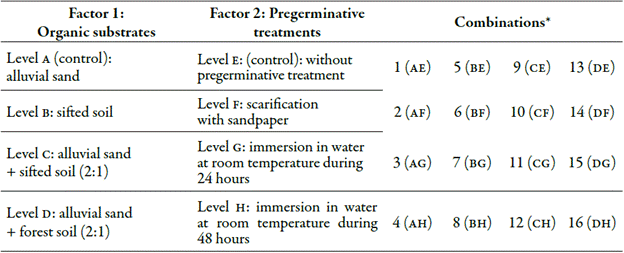Serviços Personalizados
Journal
Artigo
Indicadores
-
 Citado por SciELO
Citado por SciELO -
 Acessos
Acessos
Links relacionados
-
 Citado por Google
Citado por Google -
 Similares em
SciELO
Similares em
SciELO -
 Similares em Google
Similares em Google
Compartilhar
Ciencia y Tecnología Agropecuaria
versão impressa ISSN 0122-8706
Corpoica cienc. tecnol. agropecu. vol.19 no.2 Mosquera maio/ago. 2018
https://doi.org/10.21930/rcta.vol19_num2_art:750
Plant physiology
Germination of wild seeds of Apeiba glabra Aubl. (Malvaceae) and initial plant growth
1 Researcher, Universidad Tecnológica del Chocó, Grupo de Investigación en Ciencia Animal y Recursos Agroforestales. Quibdó, Colombia. Email: i-jhon.torres@utch.edu.co. orcid.org/0000-0002-0503-837X.
2 Lecmrer and researcher, Universidad Tecnológica del Chocó, Programa de Ingeniería Agroforestal. Quibdó, Colombia. Email: d-henry.hernan@utch.edu.co. orcio:iorg/0000-0002-9596-9054.
3 Lecmrer and researcher, Universidad Tecnológica del Chocó, Programa de Ingeniería Agroforestal, Grupo de Investigación en Ciencia Animal y Recursos Agroforestales. Quibdó, Colombia. Email: d-melida.martinez@utch.edu.co.
The aim of this study was to evaluate the germination of wild seeds of Apeiba glabra Aubl., as well as plant growth (in height and diameter) and survival. The experimental design used was completely randomized with a factorial arrangement and 16 factors, resulting from combinations of substrates and pregerminative treatments. The experiment was developed in two germination beds previously built under shade and solar exposure conditions. Sowing was comprised of 1,920 seeds and the evaluation process was carried out during 7S days. Seed scarification with sandpaper and immersion in water for 48 hours increased germination by 33% and 34 %; moreover, these values increased to more than SO% by evaluating the interaction with a substrate composed of sifted soil and sifted soil + sand in a 2:1 ratio. Growth results in diameter and height showed significant differences among factors and light conditions, both in diameter and height (p < 0.05). Seedling growth and survival were higher with the factors comprised of sifted soil (with and without pregerminative treatment). Furthermore, for propagation purposes and under our study conditions, Apeiba glabra responds well when using sifted soil and scarification with sandpaper.
Keywords: Chocó; corcho; plant propagation; pregerminative treatments; survival; tree nursery
El objetivo del presente trabajo fue evaluar la germinación de semillas silvestres, el crecimiento (en altura y diámetro) y la supervivencia de plantas de Apeiba glabra Aubl. El diseño experimental fue completamente aleatorizado con arreglo factorial y 16 factores, resultantes de combinaciones de sustratos y tratamientos pregerminativos. El experimento se desarrolló en dos camas de germinación previamente construidas bajo sombra y con exposición solar. La siembra incluyó 1.920 semillas, y el proceso de evaluación se realizó durante 7S días. La escarificación con lija y el remojo de las semillas en agua durante 48 horas incrementaron la germinación al 33 % y el 34%. Estos valores aumentaron a más del SO% cuando se evaluó la interacción con el sustrato de tierra cernida y de arena + tierra cernida en una proporción de 2:1. Los resultados del crecimiento mostraron diferencias significativas entre factores y condiciones lumínicas, tanto en diámetro como en altura (p < 0,05). El crecimiento y la supervivencia de las plántulas fueron mayores con los factores compuestos por tierra cernida (con y sin pregerminativos). En las condiciones de estudio, Apeiba glabra tiene una buena respuesta para su propagación con el uso de tierra cernida y escarificación con lija.
Palabras clave: Chocó; corcho; propagación vegetal; supervivencia; tratamientos pregerminativos; vivero forestal
Introduction
The specific location of the department of Chocó within Colombia influences its biodiversity and soils, and subsequently, its forest development (Torres-Torres, Mena, & Álvarez, 2016, 2017); in this sense, this has promoted timber exploitation until a point where it has become an important source of income and work for local population (Martínez, Torres-Torres, & Medina, 2015).
However, when productive activities are carried out without technical criteria on conservation and environmental protection, the strategic ecosystems and the environmental offer of the exploitation area are affected (Klínger et al., 2011).
Within the forest resources with socioeconomic importance and potential in Chocó, we find the species Apeiba glabra Aubl. known in Colombia as "peine mono" or "corcho': a forest species belonging to the Malvaceae botanical family.
This species achieves important ecosystem functions, including protection of watercourses (rivers and streams) and is a food source for wildlife species, specifically monkeys and macaw parrots, who are responsible for dispersing their seeds (Roman, De Liones, Sautu, Deago, & Hall, 2012). In addition, it is used as shade in cultivation practices under tree cover (Neita, Cortés, & Madrigal, 2004).
Its low density characterizes the wood of A. glabra so it is widely used as a core in slatted boards for doors, as well as for the production of acoustic veneers, tongue-and-groove strips for ceilings, roof coverings, handicrafts, cushioning and carpentry, in general. These attractive features have motivated its irrational exploitation and use, which has affected directly their perpetuity in the forests of the region (Cordero et al., 2003, Díez & Moreno, 1999, Linares, 1994).
Between the years 2010 and 2013 in the municipalities of Bojayá, Cantón de San Pablo (district), Cértegui, Nóvita, Río Quito and Quibdó, approximately 4,218 m3 of this wood (1,406 m3/year) were used. The wood was transported to the cities of Bello, Bogotá, Ibagué, Manizales, Medellín, Quibdó, Rionegro and Turbo (Corporación Autónoma Regional para el Desarrollo Sostenible del Chocó [Codechocó], 2013). This is the reason why this species is currently considered as threatened in the department of Chocó (Klínger et al., 2011).
Moreover, at the regional level, few actions have been undertaken to allow its recovery and sustainability. Furthermore, information on its germination, growth and initial adaptation in the nursery is limited, making it difficult to manage.
Regarding germination practices, the use of wild seeds is an alternative for reforestation, as these facilitate the adaptation of seedlings propagated to the final planting site; however, currently this kind of studies are scarce.
For this reason, various authors as Mosquera, Medina and Martínez (2011), Pinilla et al. ( 2016) and Torres-Torres, Medina, Pinilla, Córdoba and Martínez (2017) have stated that it is necessary to investigate the technical and scientific guidelines for an adequate germination and initial growth based on regional resources, in order to reduce propagation costs.
In search for alternatives to recover and conserve threatened forest species of ecological and socio economic importance, the use of organic substrates such as alluvial sand, forest soil, ant soil, litter and rice husks have been suggested (Aparicio, Cruz, & Alba, 1999; Garzón, Montenegro, & López, 2005; Mosquera et al., 2011).
Likewise, various studies have recommended the use of mechanical scarification of seeds and their immersion in water as pregerminative treatments, considering different temperatures and periods (Belloso & Mazariego, 2013; Cordero et al., 2003; Pinilla et al, 2016; Torres-Torres, Medina et al., 2017).
Considering the aforementioned, the aim of this study was to evaluate the germination of wild seeds and the initial growth of A. glabra under nursery conditions in the municipality of Istmina, department of Chocó, using regional organic substrates and different pregerminative treatments, and also considering two luminosity conditions (free sun exposure and under shade).
Materials and methods
The study was carried out at Granja Escuela Agroecológica [Agroecological School Farm] of Institución Educativa Agropecuaria Gustavo Posada [Agricultural Educational Institution Gustavo Posada] in the municipality of Istmina (Chocó), Colombia, located at 05°07'54" N and 76°41'03" W, at an altitude of 76 m a.s.l. The region has an average temperature of 25 oC and an average annual rainfall of more than 8,000 mm.
Among the most important economic activities carried out in the municipality mining, forestry, subsistence agriculture and commercialization stand out (Torres-Torres, Medina et al., 2017).
Experimental design
The experiment was established as a completely randomized design with factorial arrangement. Each factor had three replicates, and the combination of the levels (organic substrates and pregerminative treatments) resulted in 16 factors (figure 1), which were subjected to two light conditions (table 1).
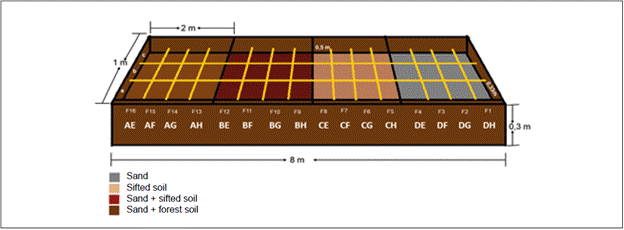
Source: Elaborated by the authors
Figure 1 Graphical representation of the experimental design used in this study.
Plant material and substrates
One thousand nine hundred and twenty (1,920) seeds were used, and these were obtained from two seed trees located in a secondary forest located in the municipality of Medio Baudó, department of Chocó, Colombia. Seed was collected manually in the month ofMay2016, one day after having fallen to the ground (figure 2c).
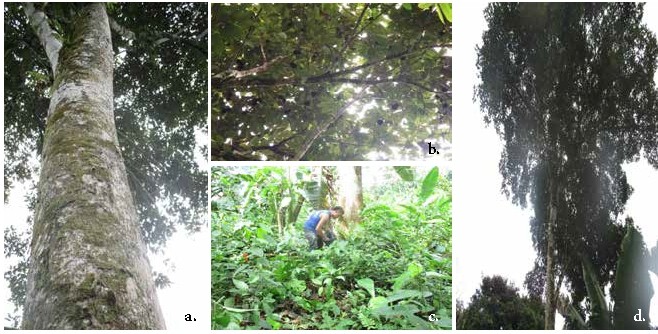
Figure 2 Apeiba..glabra Aubl a and d. Seed trees; b. Crown and fruits of one of the seed trees; c. Seed collection.
Seed trees showed the following dasometric parameters: one of the trees had a diameter at breast height (DBH) of 60 cm, a branch height of 16m and a total height of 20 m. On the other hand, the second tree had a DBH of 40 cm, a branch height of 13m and a total height of 18m (figure 2).
In general terms, arboreal individuals showed optimal phenotypic characteristics with straight stems and without pathogen attack signs. The plant material collected was mixed before the experiment.
The substrates used in this study were collected in the municipality of lstmina with help from the community (around the experimental site).
Gremhouse construction or area adjustment for planting
A temporary nursery of 16 x 16m was built in which two germination beds were adapted according to each luminosity condition, with the following dimensions: 1m wide x 8 m long x 0.30 m of depth.
The light environment was partially controlled in the under shade light condition (SM) using a polyshade mesh, and the free sun exposure condition (SL) had an opacity of 0%.
Substrate disinfection and preparation
The substrates used in this study were disinfected using invetrin and 20% formaldehyde. Moreover, 10 ml of formaldehyde and 10 ml of invetrine were mixed for every 20 liters of water and was applied to the organic substrates until completely moistened. At the end of this procedure, the material was covered with a black plastic, which was uncovered every 24 hours to remove and oxygenate the substrate; after four days disinfection was completed.
Seed planting
Sixty A.glabra seeds were planted per factor (30 per experimental unit), for a total of 960 for each light condition and 1,920 for the entire experiment. Seeds were planted at a distance of 5 x 5 cm and at a depth of 0.5 cm.
Variables assessed
Following the criteria suggested by Rivera, Peñuela, Jiménez and Vargas (2013) , germination was evaluated during 30 days, and plant growth (in diameter and height) and survival was assessed during 45 days.
Cultural management practices
Cultural management practices included: 1) daily irrigations whose amount depended on the climatic conditions of the study area, particularly precipitation ( i.e. if rainfall occurred every two days or in less prolonged intervals, two daily irrigation sessions were carried out; on the contrary, in days with high temperatures, four irrigation sessions were carried out). 2) biweekly weeding, although in some occasions rains promoted rapid weed growth, so the experimental site was weeded weekly.
Monitoring
Germination was recorded daily once the cotyledons emerged from the substrate, and data was registered in a field format. When this process was completed, monitoring growth both in diameter as well as in height continued, which was evaluated simultaneously with seedling survival. These measures were taken every eight days.
With this same frequency, height was measured from the base of the stem of the seedling to its apex, using a 3 m flexometer, while the diameter was measured from the base with a calibrator or digital caliper (electronic caliper).
In addition, during each visit to the nursery the state of the seedlings was observed in order to establish the survival of the species under study. The values obtained in each monitoring session were recorded in a field form, and with these data, the germination percentage (G%) was calculated using the following equation:
(G%) = (Sg/Ss) × 100 %
Where:
Sg = germinated seeds
Ss = sown seeds
Results and discussion
Germination
The species A. glabra has epigeous germination, which began six (6) days after seeds were sown. Our result differs from what Aguirre and León (2012), Román et al. (2012) and Salazar and Soihet (2001) found, as they state that the germination of this species starts between 12 and 18 days after planting.-
Our result may be due to the fact that in this investigation the time elapsed between seed harvesting and sowing was shorter compared to the works carried out by the above mentioned authors, who carried out seed storage tests prior to the germination tests; this fact influenced the loss of moisture of their propagation material.
Additionally, the rainfall values obtained in the study site of the aforementioned works were lower compared to the ones found in our study; this may have delayed the germinative process of the seeds (Suárez & Melgarejo, 2010).
The germinative process was extended until day 60 (when the last seed germinated in factor 11). This value is lower than the one obtained by Román et al (2012) in nurseries located in Panama. In this sense, Garzón et al. (2005), Pérez (2003) and Suárez and Melgarejo (2010) argue that factors such as the natural latency process of these seeds, the environmental temperature, oxygen and light amounts, as well as the moisture content of the substrate where the seeds are germinated, influence the time germination takes. Therefore, these authors suggest that seed irrigation and the use organic substrates mixed with sand should not be neglected.
Differences in the germination time of A. glabra seeds found in our study compared to the works above mentioned can also be due to climatic differences found in the study areas, especially factors such as rainfall (Suárez & Melgarejo, 2010).
Germination percentage through pregerminative treatments were relatively low (table 2). These values can be attributed to events related to seed selection, as in a large amount of the fruits of this species, ca. SO% of the seeds do not germinate; this is dueto different factors associated with dormancy (when they are removed from the fruit) (Salazar & Soihet, 2001). For this reason, Román et al. (2012) suggest carrying out feasibility tests of A. glabra seeds to increase these percentages.
Seed germination planted under free sun exposure and shade conditions was 30% and 31%, respectively (table 2), and these values are similar to those obtained by Aguirre and León ( 2012) in an under shade structure (30%). Likewise, germination differences considering different lighting conditions were not significant, suggesting that luminosity does not affect germination of A. glabra seeds directly (Acuña & Garwood, 1987).
Table 2 Germination through pregerminative treatments
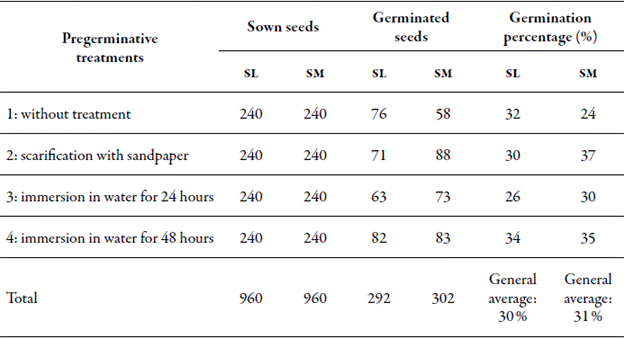
SL: under free sun exposure conditions; SM: under shadow conditions.
Source: Elaborated by the authors
The interaction of the substrates composed of sifted soil, and of sand with sifted soil in a 2:1 ratio with pregerminative treatments consisting of scarification with sandpaper and seed immersion in water at room temperature for 48 hours increased germination values (exceeding 50%) (table 5).
Table 5 Germination and survival of A. glabra under different light conditions by factor
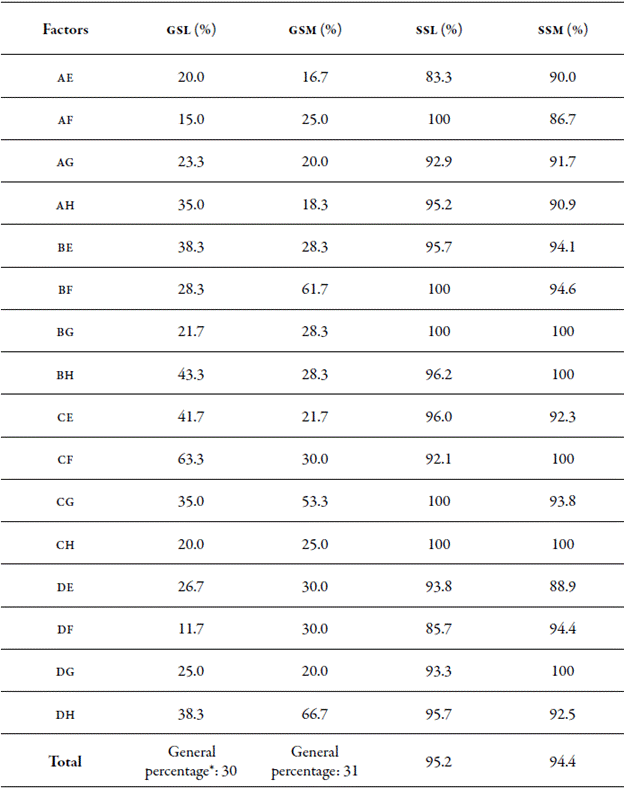
GSL: germination under free sun exposure conditions; GSM: germination under shadow conditions; SSL: survival under free sun exposure conditions; SSM: survival under shadow conditions
* The general germination and survival values corresponds to the totality of the seeds used in our study.
Source: elaborated by the authors
From this result, we can infer that both pregerminative treatments and their substrate combinations used have a positive influence on the germination of A. glabra seeds. This differs from the studies of Aguirre and León (2012) and Cordero et al. (2003), who obtained a germination of 30 %.
From this result, we can infer that both pregerminative treatments and their substrate combinations used have a positive influence on the germination of A. glabra seeds. This differs from the studies of Aguirre and León (2012) and Cordero et al. (2003) , who obtained a germination of 30 %.
Plant growth in diameter and height
Results of growth in diameter and height of A. glabra seedlings suggest that there is a significant difference between the various factors considered and light conditions. Furthermore, the interactions between these also showed significant differences, since the p-values were lower than the confidence level (Tukey: p < 0.05) (tables 3 and 4).
Table 3 Analysis of variance of plant growth in diameter and height with total and partial solar exposure
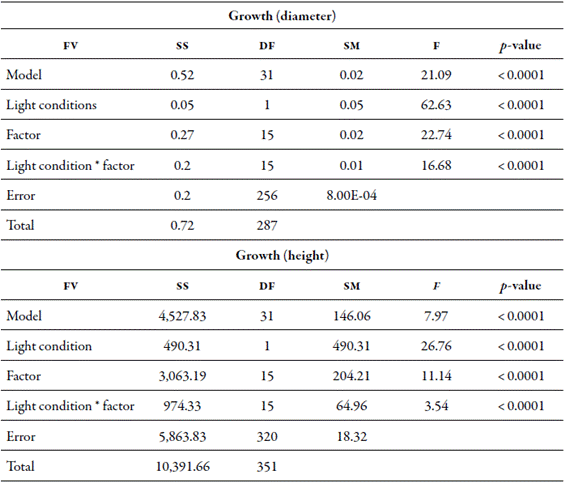
FV: variation origin; SS: sum of squares; DF: degrees of freedom; SM: square mean; and F: f-test
Source: Elaborated by the authors
Table 4 A. glabra seedlings growth in diameter and height with total and partial sun exposure conditions
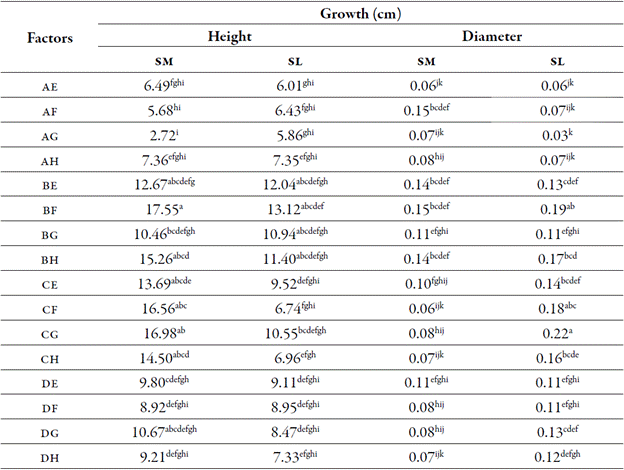
AE: alluvial sand without pregerminative treatment; AF: alluvial sand and scarification with sandpaper; AG: alluvial sand and seed immersion in water at room temperature for 24 hours; AH: alluvial sand and seed immersion in water at room temperature for 48 hours. BE: sifted soil without pregerminative treatment; BF: sifted soil and scarification with sandpaper; BG: sifted soil and seed immersion in water at room temperature for 24 hours; BH: sifted soil and seed immersion in water at room temperature for 48 hours. CE: alluvial sand + sifted soil 2:1 without pregerminative treatment; CF: sifted soil + sand in a 2:1 ratio and scarification with sandpaper; CG: sifted soil + sand in 2:1 ratio and seed immersion in water at room temperature for 24 hours; CH: alluvial sand + sifted soil 2:1 and seed immersion in water at room temperature for 48 hours. DE: alluvial sand + forest soil 2:1 without pregerminative treatment; DF: alluvial sand + forest soil 2:1 and scarification with sandpaper; DG: alluvial sand + forest soil 2:1 and seed immersion in water at room temperature for 24 hours; DH: alluvial sand + forest soil 2:1 and seed immersion in water at room temperature for 48 hours. Means with the same letter are not significantly different (Tukey: p > 0.05).
Source: Elaborated by the authors
Seedlings of A. glabra under free sun exposure experienced a greater growth in diameter (average of 0.163 cm) compared to those under shade conditions (average of 0.130 cm), which makes them statistically different (Tukey: p > 0.05).
Under shade conditions the best growth values in diameter were obtained with the factors AF (alluvial sand and scarification with sandpaper), BF (sifted soil and scarification with sandpaper), BE (sifted soil without pregerminative treatment) and BH (sifted soil and seed immersion in water at room temperature for 48 hours), with values of 0.15, 0.15, 0.14 and 0.14 cm, respectively.
Under free sun exposure the best values were found in the CG factors (sifted soil + sand in a 2:1 ratio, and seed immersion in water at room temperature for 24 hours), BF, CF (sifted soil + sand in a 2:1 ratio, and scarification with sandpaper), and BH, with values of 0.22, 0.19, 0.18 and 0.17 cm, respectively (table 4).
Accordingt Tukey's mean separation test, these results are significantly different from the ones obtained under SM and SL light conditions (table 4). Furthermore, in relation to the quality of the organic substrates used, Belloso and Mazariego (2013) and Mosquera et al. (2011) suggest that these contain a large amount of humus and organic matter, which stimulates seedling growth both in diameter and in height.
On the other hand, the lower growth in SL was found in the AG factor (sand and seed immersion in water at room temperature for 24 hours) with a value of0.03 cm; and in SM the lowest value (0.06 cm) was found in factor AE (sand alluvial without pregerminative treatment).
It should also be noted that the growth of A. glabra seedlings in the factors with forest soils (DE, DF, DG and DH) was lower compared to those found with sifted soil (BE, BF and BG) (table 4). This can be related to the compaction that occurs in substrates composed of forest soil without sifting, so Belloso and Mazariego (2013) recommend using sifted soil for germination.
Tukey's separation of means test (p>0.05) indicates that in seedling height growth there is a statistically significant difference among the various light conditions evaluated. The highest growth value was obtained under shade conditions ( SM), with an average of 11.16 cm, while under free sun exposure conditions (SL) an average value of8.80 cm was found.
This suggests that during its growth stage, A.glabra does not require direct sun light; thus, we can affirm that this species belongs to the group of semiheliophytes (Román et al., 2012; Salazar & Soihet, 2001). However, this result contrasts with those obtained by authors as Acuña and Garwood (1987) and Román et al. (2012), who suggest that this species reaches heights of 20 cm in three months.
Under SM conditions, the highest seedling height growth was observed with the factors BF (17.55 cm), CG (16.98 cm), CF (16.56 cm) and BH (15.26 cm); on the other hand, under SL conditions, the highest seedling height growth values were obtained with BF (13.12 cm), BE (12.04 cm), BH (11.40 cm), BG (10.94 cm) and CG (10.55 cm) (table 4).1hese factors are comprised of substrates containing sifted soil, which have the capacity to retain more water for the plant, in addition to its nutritional content (Belloso & Mazariego, 2013).
The lowest growth in height was found in the factors AE, AF, AG, AH, DE, DF, DG and DH (table 4), and were significantly different from the rest of the results obtained (Tukey: p > 0.05). These factors were composed of alluvial sand and alluvial sand + forest soil in a 2:1 ratio.
In the specific case of substrates composed of forest soil, this material began to show compaction signs two months seed germination started, which could have had a negative influence on the growth of A. glabra seedlings. This validares the concept supported by Belloso and Mazariego (2013) , who express that the substrates with the highest content of sand and forest soil are not adequate for the initial growth of forest seedlings in the nursery.
Plant survival
Under SL and SM light conditions, survival was 95 % and 94 %, respectively (table 4 ). With SL, factors AF, BF, BH, CG and CH showed the highest percentages, while with SM the highest percentages were found in factors BG, BH, CF, CH and DG (all with values of 100%). These values are higher compared to those published by Aguirre and León (2012) , who reported survival values of 7S% for this same species.
Our results validate the importance of the substrates composed of sifted soil and sand + sifted sand in a 2:1 ratio for the propagation of A. glabra in nursery (table 5).
On the other hand, the lowest survival percentages were found in the AE factor, with values of 83.3 % and 86.7 % in SL and SM, respectively.
Conclusions
The interactions of pregerminative treatments including scarification with sandpaper and seed immersion in water at room temperature for 48 hours using the substrates sifted soil or sand + sifted soil in a ratio of 2:1 increased the germination percentage of A.glabra seeds.
The light conditions used in this study did not affect directly the germination of A. glabra seeds. Significant growth in diameter and height values of the seedlings found with both SL and SM light conditions were obtained in substrates containing sifted soil, which can be attributed to their high organic matter content.
Under both SL and SM light conditions, substrates comprised of sand and sand + forest soil in a ratio of 2:1 experienced the lowest growth values both in diameter as well as in height. This event that may be due to the low nutritional content of the sand as well as to the compaction process of which the substrate that contains forest soil is subject to, preventing free plant root development.
How to cite this article: Torres-Torres, J. J., Medina-Arroyo, H. H., & Martínez-Guardia, M. (2018). Germination of wild seeds of Apeiba glabra Aubl. (Malvaceae) and initial plant growth Corpoica Ciencia y Tecnología Agropecuaria, 19(2), 337-349.
Disclaimer: This study was carried out by Grupo de Investigación Ciencia Animal y Recursos Agroforestales [Research Group in Animal Sciences and Agro forestry Resources] of Universidad Tecnológica del Chocó (UTCH). Within this document there are significant contributions of all the authors who agree on its publication, and state that there are no conflicts of interest in this study.
Acknowledgements
The authors wish to thank Universidad Tecnológica del Chocó (·UTCH) for financing this work. Likewise, the authors want to acknowledge Tobías Francisco Asprilla Murillo and Cristian Estiven Aguilar, as well as all the teachers and students of Institución Educativa Agropecuaria Gustavo Posada de Istmina who helped carry out the field activities of this study.
REFERENCES
Acuña, P. l. & Garwood, N. C. (1987). Efecto de la luz y de la escarificación en la germinación de las semillas de cinco especies de árboles tropicales secundarios. Revista Biolog!a Tropical 35(2), 203-207. [ Links ]
Aguirre, M. Z. & León. A. N. (2012). Conocimiento inicial de la fenología y germinación de diez especies forestales nativas en El Padmi, Zamora Chinchipe. Revista Cedamaz, 2(1), 63-72. [ Links ]
Aparicio, A., Cruz, H.,& Alba, J. (1999). Efecto de seis sustratos sobre la germinación de Pinus patula Sch. et Cham, Pinus montezumae Lamb. y Pinus pseudostrobus Lindl. en condiciones de vivero. Foresta Veracruzana, 1(2), 31-34. [ Links ]
Belloso, P. A. & Mazariego, L. B. (2013). Evaluación de cinco sustratos y tres métodos de escarificación en la germinación de semillas de cuatro especies forestales (tesis de doctorado). Universidad de El Salvador, San Salvador, El Salvador. [ Links ]
Cordero, J., Mesén, F., Montero, M., Stewart, J., Boshier, D., Chamberlain,J., ... Declefsen, G. (2003). Descripciones de especies de árboles nativos de América Central. En J. Cordero & D. H. Boshier (Eds.). Árboles de Centroamérica: un manual para extensionistas (pp. 311-958). Turrialba, Costa Rica: Centro Agronómico Tropical de Investigación y Enseñanza (Catie), Oxford Forestry Institute (OFI). [ Links ]
Corporación Autónoma Regional para el Desarrollo Sostenible del Chocó (Codechocó). (2013). Base de datos de volúmenes de madera movilizados en el departamento del Chocó 2009-2013. Quibdó, Colombia: Codechocó. [ Links ]
Díez, M. C. & Moreno, H. F. (1999). Morfología de semillas y plántulas de árboles de los bosques húmedos tropicales del suroriente de Antioquia, Colombia (n parte). Revista Facultad Nacionalde Agronomía, 52( 1) , 365-394. [ Links ]
Garzón, G., Montenegro, E., & López, F. (2005). Uso de aserrín y acículas como sustrato de germinación y crecimiento de Quercus humboldtii (roble). Colombia Forestal 4 9(18), 98-108. [ Links ]
Klínger, W, Roa, R., Ibargüen, T., Rengifo, 0., Barcos, R., Mosquera, H., & Perea J. A . (2011). Estado de las especies forestales amenazadas. En W Klínger, G. Ramírez & J. M. Guerra (Eds.). Aportes al conocimiento de los ecosistemas estratégicos y las especies de interés especial del Chocó biogeográfico (Parte I, pp. 92-117). Cali, Colombia: Instituto de Investigaciones Ambientales del Pacífico (IIAP). [ Links ]
Linares, E. (1994). Inventario preliminar de las plantas utilizadas para elaborar artesanías en Colombia. Universitas Scientiarium,2( 1), 7-43. [ Links ]
Martínez, M., Torres-Torres, J. J., & Medina, H. H. (2015). Aprovechamiento forestal maderable en cuatro municipios del departamento de Chocó, Colombia. Revista de Investigación Agraria y Ambiental 6(2), 57-74. [ Links ]
Mosquera, D. E., Medina, H. H., & Martínez, M. (2011). Germinación y crecimiento inicial en abarco Cariniana pyriformis: una alternativa para su conservación. Revista Biodiversidad Neotropical 2( 1), 53-59. [ Links ]
Neita, J. C., Cortés, H., & Madrigal, A. (2004). Los himenópteros asociados a una parcela agroforestal de Borojoa patinoi, Cedrela odorata, Apeiba aspera e Inga spectabilis en la granja de la Universidad del Chocó, municipio de Lloró, Chocó. Revista Colombiana de Entomolog!a, 30(2), 233-239. [ Links ]
Pérez, F. (2003). Germinación y dormición de semillas. En A. Sánchez, M. Arroyo & R. M. Navarro (Eds.). Material vegetal de reproducción: manejo, conservación y tratamiento (pp. 117-200). Sevilla, España: Junta de Andalucía. [ Links ]
Pinilla, H., Medina, H. H., Torres-Torres, J. J., Córdoba, E., Córdoba, J. C., Mosquera, Y., & Martínez, M. (2016). Propagación y crecimiento inicial del abarco ( Cariniana pyri.fonnis Miers), utilizando semillas silvestres. Revista de Investigación Agraria y Ambiental 7(2), 87-79. [ Links ]
Rivera, L., Peñuela, M., Jiménez, E., & Vargas, M. (2013). Ecología y silvicultura de especies útiles amazónicas. Leticia, Colombia: Universidad Nacional de Colombia. [ Links ]
Román, F., De Liones, R., Sautu, A., Deago, J., & Hall, J. S. (2012). Guía para la propagación de 120 especies de árboles nativos de Panamá y el neotrópico. New Haven, EE. UU: Environmental Leadership and Training Initiative (ELTI). [ Links ]
Salazar, R. & Soihet, C. (2001). Manejo de semillas de 75 especies forestales de América Latina. Turrialba, Costa Rica: Centro Agronómico Tropical de Investigación y Enseñanza (Catie). [ Links ]
Suárez, D. & Melgarejo L. M . (2010). Biología y germinación de semillas. En L. M. Melgarejo (Ed.). Experimentos en Jisiolog!a vegetal (pp. 13-25). Bogotá, Colombia: Universidad Nacional de Colombia. [ Links ]
Torres-Torres, J. J., Medina, H. H., Pinilla, H., Córdoba, E., & Martínez, M. (2017). Propagación en vivero de la especie forestal Dipteryx oleifora Benth mediante semillas. Revista Politécnica, 13(24), 19-26. [ Links ]
Torres-Torres, J. J., Mena, V. E., & Álvarez, E. (2016). Composición y diversidad florística de tres bosques húmedos tropicales de edades diferentes, en el Jardín Botánico del Pacífico, municipio de Bahía Solano, Chocó, Colombia. Revista Biodiversidad Neotropical 6( 1), 12-21. [ Links ]
Torres-Torres,J. J., Mena, V E., & Álvarez, E. (2017). Carbono aéreo almacenado en tres bosques del Jardín Botánico del Pacífico, Chocó, Colombia. Entramado, 13( 1), 200-209 [ Links ]
Received: September 01, 2017; Accepted: March 15, 2018











 texto em
texto em 

